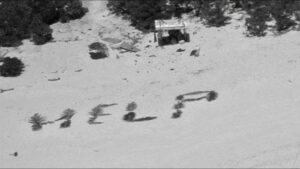To most people, swimming the English Channel once is impressive; twice is astonishing. But on September 17, Sarah Thomas pushed the boundaries of human endurance and completed the first-ever four-way crossing.
Starting in the early hours of Sunday, September 15, she completed the swim in a staggering 54 hours and 10 minutes. Following the shortest route between England and France, this swim should have been 135km, but with strong currents and tides pushing her off course, the distance actually totaled over 200km.
During the swim, Thomas only used liquids to fuel herself. Every 30 minutes, a protein recovery drink mixed with electrolytes and caffeine was thrown to her on a rope from her safety boat.
Her route on her first three laps was almost identical, but on her record-breaking fourth crossing, she had to battle rough seas and heavy swells as well as fatigue. She eventually completed the final leg in just over 17 hours, by far the longest section. She did the first three crossings in 11:26, 12:24 and 12:57 respectively. Considering that the average Channel crossing time is 13:22, her feat is truly incredible.

Sarah Thomas’s route on each lap of the Channel. Photo: track.rs
ExWeb spoke to celebrated open-water swimmer Lynne Cox about what this challenge means within the marathon swimming world. Lynne successfully crossed the Channel herself at ages 15 and 16, setting new speed records on both occasions. Since then, she has been pushing the boundaries of open water and cold-water swimming.
“To many marathon swimmers, this is as significant as astronauts landing on the moon,” said Cox. “Sarah pushed beyond all mental, physical and spiritual boundaries, and showed us what she was capable of, what humankind is capable of. She has redefined the sport. We are in awe.”

Photo: Jon Washer
Cox continued: “The physical challenges of a 100+ mile swim are extraordinary. Not only do you need to be in excellent physical shape, but you must also be able to endure the effects of long-term exposure to saltwater, the sun, wind, sea conditions and fatigue…your arms feel like weights, your neck and back hurt from twisting, your lips, mouth and throat swell from the salt water…you become dehydrated. Sunburn is a great risk.
“Mental preparedness is just as, if not more, important at the start of a swim. You must believe that you can succeed. In Sarah’s case, she had a coach she believed in and a support crew of people she trusted and who knew how to encourage her — and did so at just the right times.”
Despite the fatigue and the fact that she was stung in the face by jellyfish, Thomas noted that dealing with the saltwater was the worst part of the swim. “It really hurts your throat, your mouth and your tongue.”
Traditionally, the frigid water was one of the biggest challenges of the Channel, but climate change seems to have softened that aspect. Water temperatures during her swim were 17.5 to 18.3 degrees — “not as cold as I thought it might be,” Thomas admitted.

Photo: Jon Washer
Thomas has been endurance swimming since 2007. The idea of crossing the English Channel more than once came to her after she completed her first crossing in 2012. When standing on the beach in France, she felt as if she could have happily swum back to England.
In 2017, she broke records with a 167km swim in the comparatively balmy waters of Lake Champlain, New York. After that, her training for the four-way Channel crossing began. During her training, Thomas was diagnosed with an aggressive form of breast cancer, but incredibly, she continued training throughout her chemotherapy, surgery and radiation as much as she could. A year later, she has completed both her treatments and the epic challenge she set for herself.
Lynne Cox summed it up: “We have witnessed something amazing. Something that will stay with us all our lives.”






